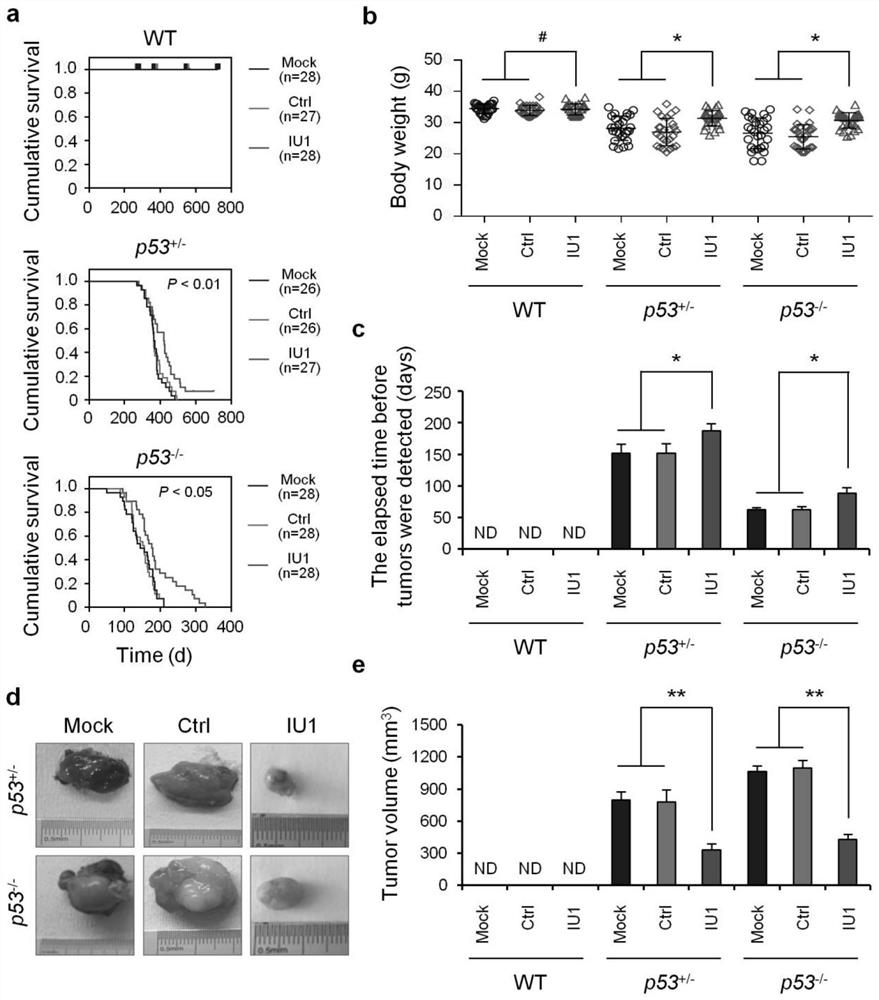Application of iu1 in the preparation of drugs for the treatment of p53-deficient tumors
A defect, tumor technology, applied in the field of tumor drugs, can solve problems such as difficulty in obtaining clinical efficacy
- Summary
- Abstract
- Description
- Claims
- Application Information
AI Technical Summary
Problems solved by technology
Method used
Image
Examples
Embodiment 1
[0022] Spontaneous tumor formation and the therapeutic effect of IU1 were observed in p53 heterozygous knockout mice and p53 homozygous knockout mice.
[0023] All experimental procedures were approved by the guidelines of the Animal Care and Use Committee (IACUC) of Tongji University School of Medicine (SYDW-19-215). Experiments were performed in 9-month-old wild-type and p53 heterozygous knockout (p53+ / -) mice and 3-month-old p53 homozygous knockout (p53- / -) mice. Genotyping of genomic DNA from tail biopsies was performed using Trp53-based polymerase chain reaction (PCR). The PCR reaction system is as follows:
[0024]
[0025]
[0026] Wherein, oIMR7777 5'ACAGCGTGGTGGTACCTTAT3' (SEQ ID No.1);
[0027] oIMR7778 5'TATACTCAGAGCCGGCCT3' (SEQ ID No. 2);
[0028] oIMR8306 5' CTATCAGGACATAGCGTTGG3' (SEQ ID No. 3).
[0029] The PCR amplification procedure is as follows:
[0030]
[0031] Mice treatments were administered as twice weekly intraperitoneal injections. The ...
Embodiment 2
[0035] Imaging analysis of IU1 suppresses the number and type of tumors in p53-deficient mice
[0036] The location, number and type of tumors in mice were analyzed using conventional X-ray, MICRO-CT and MRI.
[0037] The result is as figure 2 shown. figure 2 X-ray, MICRO-CT and MRI analysis and typing of primary tumors in p53 gene homozygous deficient mice. p53 homozygous deficient mouse MLT ( figure 2 -a), p53 gene homozygous deficient mouse STS ( figure 2 -b) and p53 gene homozygous deficient mouse OSA ( figure 2 -c) X-ray, MICRO-CT and MRI analysis. figure 2 -d is the effect of IU1 on the number of cancer types in wild type, p53 heterozygous knockout mice and p53 homozygous knockout mice. figure 2 -e is the number of mice with MLT or OSA in p53 heterozygous knockout mice and p53 homozygous knockout mice. CTRL, control group; MLT, malignant thymic lymphoma; MOCK, untreated mice; NA, not applicable; OSA, osteosarcoma; STS, soft tissue sarcoma; WT, wild type.
...
Embodiment 3
[0040] Validation of the molecular mechanism of IU1 tumor suppressor using primary cancer cells and tumor tissue from spontaneously tumorigenic mice
[0041] Mouse spontaneous tumorigenic primary cancer cells were cultured in DMEM medium containing 10% (V / V) fetal bovine serum (FBS), 100 μg / ml penicillin, and 100 mg / ml streptomycin, and flow cytometry was performed. Experiments analyzing the effect of IU1 on cell cycle and distribution in p53 heterozygous knockout mice.
[0042] Routine Western blotting analysis was used to detect the protein levels of cell cycle, senescence and apoptosis-related markers in p53 heterozygous knockout mice.
[0043] The detailed experimental steps are as follows: using lysis buffer, lyse tissue samples, and use BCA protein concentration assay kit to determine the protein concentration of the samples. Add an appropriate amount of concentrated SDS-PAGE protein loading buffer to the collected protein samples. Heating at 100℃ or boiling water bath...
PUM
 Login to View More
Login to View More Abstract
Description
Claims
Application Information
 Login to View More
Login to View More - R&D
- Intellectual Property
- Life Sciences
- Materials
- Tech Scout
- Unparalleled Data Quality
- Higher Quality Content
- 60% Fewer Hallucinations
Browse by: Latest US Patents, China's latest patents, Technical Efficacy Thesaurus, Application Domain, Technology Topic, Popular Technical Reports.
© 2025 PatSnap. All rights reserved.Legal|Privacy policy|Modern Slavery Act Transparency Statement|Sitemap|About US| Contact US: help@patsnap.com



